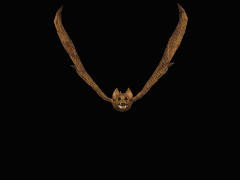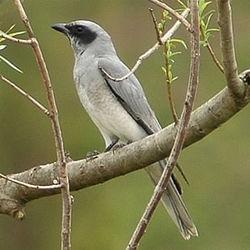


|
Campephagidae:
The cuckoo-shrikes, the Campephagidae family are small to medium-sized passerine bird species found in the subtropical and tropical Africa, Asia and Australasia. The 84 species are found in eight (or nine) genera which comprise five distinct groups, the 'true' cuckoo-shrikes (Campephaga, Coracina, Lobotos, Pteropodocys and Campochaera) the trillers (Lalage), the minivets (Pericrocotus), the flycatcher-shrikes (Hemipus). The wood-shrikes (Tephrodornis) were often considered to be in this family but are probably closer to the helmetshrikes or bushshrikes. Another genus, Chlamydochaera, which has one species, the Black-breasted Fruithunter was often placed in this family but has now been shown to be a thrush (Turdidae). Cuckoo-shrikes are neither closely related to the cuckoos or shrikes, the name probably comes from the grey colour of many of the cuckoo-shrikes. Some of the species also bear a superficial resemblance to cuckoos, and have a similar undulating flight. The grey colouration has led to one of their other names, the greybird. In some parts of the world they have also been known as caterpillar-birds, a name derived from their diet. They are in fact thought by some to be closely related to the Old World orioles (Oriolidae), although they differ strongly in some morphological characteristics (such as skull morphology and the arrangements of feathers on the wing). Overall the cuckoo-shrikes are medium to small arboreal birds, generally long and slender. They are predominately greyish with white and black, although the minivets are brightly coloured in red, yellow and black, and the Blue Cuckoo-shrike of central Africa is all-over glossy blue. The four cuckoo-shrikes in the genus Campephaga exhibit sexual dimorphism, with males that have glossy black plumage and bright red or yellow wattles, the females having more subdued olive-green plumage. Of the 84 species of cuckoo-shrike, the majority are forest birds. Some species are restricted to primary forest, like the New Caledonian Cuckoo-shrike, others are able to use more disturbed forest. Around eleven species use much more open habitat, one Australian species, the Ground Cuckoo-shrike being found in open plains and scrubland with few trees. The 'true' cuckoo-shrikes are usually found singly, in pairs, and in small family groups, whereas the minivets, flycatcher-shrikes and wood-shrikes more frequently form small flocks. There is a considerable amount of variation within the family as a whole with regards to calls, some call very infrequently and some, principally the minivets, are extremely vocal.
These are mainly insectivorous, and will take large hairy caterpillars. They have also been recorded eating small vertebrates, and some fruit, seeds and other plant matter. About four blotchy white, green or blue eggs are laid in a cup nest in a tree. Incubation is about two weeks. |
